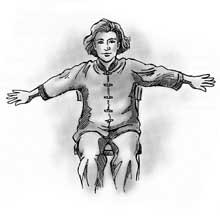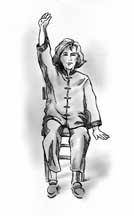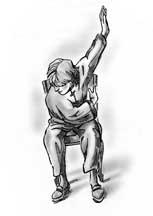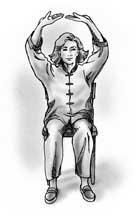Tai Chi
Seemingly simple and deceptively gentle, T’ai Chi delivers a workout that is superior to any exercise program in use today. The slow, easy to learn routines can be practiced by anyone regardless of age or level of ability. The seated version of these exercises can be practiced at home or at work, in an easy chair or a wheelchair, and without the need for expensive equipment or special clothing. As a style of martial arts that emphasizes internal power, T’ai Chi provides a life-long exercise system that delivers improved health and greater strength the longer you practice it.
Most Western exercise systems depend upon the number of repetitions and the rate of speed of each exercise for their efficacy. As Dr. Robert Chuckrow describes in The T’ai Chi Book, performing these exercises is like “trying to drive with the brakes on.” We spend much of our time contracting muscles and pitting one muscle group against another. The exercises become exhausting rather than energizing, painful and injurious rather than pleasant and healing.
Like the Western exercise systems, external fighting forms, such as karate, are recognizable by their stress on physical power. Practitioners of an external martial arts system strive to develop larger muscles and to build up calluses on their knuckles and feet.
Training in internal martial arts, such as T’ai Chi, on the other hand, concentrates on breathing exercises based on qigong and the development of ch’i (internal power) through the practice of directing the mind to command each movement.
While practitioners of external arts eventually become weaker as they age or suffer injuries, internal martial artists continue to be formidable because they maintain their chi or internal power – both mental and spiritual- in spite of injuries, disabilities, or the reduction of flexibility and strength that accompanies the aging process.
There really is nothing too surprising about successful results from the practice of T’ai Chi, for it is truly a simple, non-stressful, and most importantly, holistic exercise system. All of the movements are based on the belief that the human body contains a system of pathways along which energy travels as it nourishes and heals muscles, bones, and organs and are based on a natural but synchronized pattern of breathing.
T’ai Chi is a relaxed process, the movements slow and meditative while the mind remains alert to the relationship between the body and its surroundings. The exercises that comprise any T’ai Chi form are said to cause the release of the body’s natural energy to and through the body’s organs and systems while bones, muscles, and joints are being exercised and strengthened.
A number of studies show that many T’ai Chi practitioners have developed a marked improvement in balance, blood-pressure levels, flexibility, strength, peak oxygen intake, and body-fat percentages. Though all of the studies to date have involved the use of standing T’ai Chi exercises, I believe that a program of seated T’ai Chi, such as described in my book, T’ai Chi in a Chair, is just as beneficial.
I developed this system of seated T’ai Chi exercises while employed as the program supervisor at a local retirement community. My challenge was to find exercises that accommodated all of the participants – those in wheelchairs, amputees, stroke victims, and others of varying abilities. Most importantly, this new exercise program had to be designed in such a way that strengthening, flexibility, improved circulation, and so on, were not lost as a result of the necessary modifications. T’ai Chi proved to be the ideal solution. It lends itself to any age, level of fitness, or type of disability, and can lead to a lifetime of improved health and increased strength.
The exercises shown below and all those described in T’ai Chi in a Chair (published by Fair Winds Press, 2001) comprise a comprehensive wellness program. They are designed in such a way that they can be modified to meet specific needs. For example, many of the upper body exercises involve reaching above the head but they are equally effective if the arms are lowered to chest or shoulder height. In addition, these exercises can be practiced anywhere – at home or at the office, indoors or out – all you need is a comfortable chair and loose clothing.
Find a quiet space, put on some soothing music, if you wish, and you’re ready to go.
 Balloon Breathing
Balloon Breathing
- Begin by sitting with your back against the back of the chair. Legs should be shoulder-width apart, feet flat on the floor or on the foot rests of your wheelchair.
- Tuck your hips under slightly and curve your shoulders inward without hunching. The idea here is to keep the chi from flowing outward and away from the body. Hold your head lightly on your neck as if suspended from the ceiling by a string.
- Hold your hands lightly over your abdomen in the general area of your diaphragm. This will help you to monitor the depth of each breath.
- Breathe in deeply through your nose and hold the full breath for a second.
- Blow the stale air out through your mouth until there is no breath left and you must breathe in again.
- Repeat the deep breaths nine times or longer if necessary, until you feel completely relaxed and energized.

 Flower Bud Opens
Flower Bud Opens
- While lifting your rib cage, open your chest to the fullest extent, allowing for a deeper inhalation. Think about your first yawn of the morning. Your chest opens wide as clean, clear air enters your lungs.
- Begin with your hands in a prayer position (that is, palms pressed together, fingers pointed straight upwards) in front of your solar plexus.
- Raise your hands above your head, keeping your palms pressed together.
- When your elbows are straight, open your arms to the side sweeping them in an arc to the furthest point possible behind you. As your arms being to circle out to the side, arch your back away from the back of the chair.
- Return your arms to the prayer position and repeat nine times.
Push Up Sky/Press Down on Earth
 This exercise will stretch your arm muscles while your waistline is reduced and your abdominal muscles are tightened and strengthened. Imagine that you are creating a space between the sky and the earth and by touching each you are connecting with the energies of both.
This exercise will stretch your arm muscles while your waistline is reduced and your abdominal muscles are tightened and strengthened. Imagine that you are creating a space between the sky and the earth and by touching each you are connecting with the energies of both.
- Begin with your hands resting on your thighs.
- Bring your right arm up with the palm facing the ceiling and at the same time press downward with your left hand, palm facing the floor.
- Breathe in through your nose and expand your diaphragm.
- Bring both arms, elbows bent, to the level of your solar plexus.
- Breathe out through your mouth.
- Tighten your diaphragm and abdomen and hold until you need to breathe in again.
- Reverse your hands so that the left one reaches toward the ceiling this time and the right is pressing downward.
- Continue alternating sides, breathing in deeply as one arm ascends and the other descends for a total of eighteen repetitions.
Brushing Tree Trunk
 Balances the right left hemispheres of the brain thereby ridding the mind of distractions and uncertainty.
Balances the right left hemispheres of the brain thereby ridding the mind of distractions and uncertainty.
- Begin by raising your arms until your elbows are straight.
- Leave your left arm extended while you swing your right arm downward as you bend from the waist then across your body until your elbow is bent and your arm brushes your thighs.
- Turn your head so that you are looking up and over your right shoulder.
- Return your right arm to its upward extension and swing your left arm down across your body while bending over from the waist.
- Look up and over your left shoulder.
- Repeat nine times on each side for a total of eighteen brushes.
Centering Ch’i
 Centers the energy and rebalances the body.
Centers the energy and rebalances the body.
- Hold your hands palm up just above your lap.
- Breathe in deeply through your nose while contracting your diaphragm. It is only in this one exercise that the diaphragm is not expanded during inhalations.
- As you tighten your diaphragm and abdomen, raise your arms out to the side and up over your head to its center. Your palms are now facing the ceiling, fingers barely touching.
- Allow your arms to descend gradually in an arc out to the side.
- As you do so, exhale until there is no breath left in your lungs and relax the muscles of your diaphragm and abdomen.


